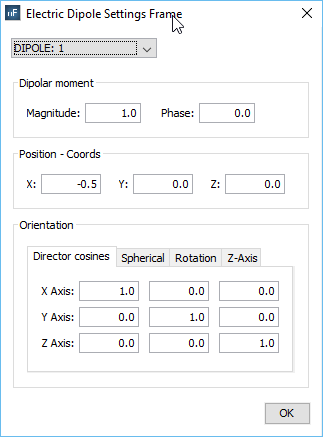Dipole Antenna
Using the "Dipole Antenna" option, the user can define the parameters for a dipole antenna that will be added to the project and processed during simulation.

The following options are available:
- Set dipoles this setting specifies how many magnetic and electric dipoles have to be
generated. This feature is covered later in this section.
- Number of magnetic dipoles: sets the number of magnetic dipoles that the generated dipole will have.
- Number of electric dipoles: sets the number of electric dipoles that the generated dipole will have.
- Components: the amplitude and phase for the dipole moment of the generated antenna.
- Position: the Cartesian center for the generated antenna. For a more precise mode, the pick-point mode can be enabled. Select Pick, then click anywhere in the 3D Panel. The position fields will be filled with the coordinates of the clicked point.
- Orientation: dipole antenna rotation. There are multiple ways of
setting the orientation.
- Director Cosines: manually set the director cosines for the dipole.
- Spherical: set the orientation using spherical system (theta, phi, alpha).
- Rotation: specify X, Y, and Z angles in degrees.
- Z-Axis: this option can be used for manually defining the local Z-axis of the dipole.
- Relative to reference plane: when this option is set, the given coordinates and rotations are considered relative to the coordinate system defined by the current reference plane. If this option is unchecked, the given position and rotation are absolute.
When the number of magnetic dipoles is greater than 0, the position and orientation of magnetic dipoles can be selected by pressing the Position button.

The selector at the top of the window lists every magnetic dipole defined in the antenna. The following settings can be defined:
- Dipolar moment: values for the magnetic dipole moment, magnitude, and phase, can be set here.
- Position: Cartesian coordinates for the magnetic dipole, relative to the location of the antenna.
- Orientation: similar to the rotation controls under Dipole tab, this setting lets the user set the rotation for this magnetic dipole using either Director cosines, Spherical, Rotation or Z-Axis values.
Similarly, when the number of electric dipoles is higher than 0, the position and rotation for every electric dipole can be set by pressing the Position button.

The behavior of this dialog is similar to the one for setting magnetic dipoles.
After every possible setting has been set, press Save to create the Dipole. When generated, the dipole is displayed as a set of red cones. The bigger one is the antenna itself. Every another small dipole represents each magnetic and electric dipole associated with the antenna.
